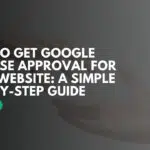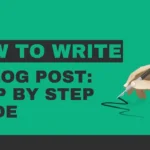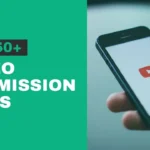🌟📝 Are you interested in exploring your ideas and abilities with fellow individuals?
If you’re considering starting a blog but feeling uncertain about where to begin due to your limited background in blogging, you may be wondering how to start a blog. 🤔
Within this comprehensive guide, I shall impart straightforward pointers to assist you in launching a blog without any prior blogging knowledge, regardless of whether you are a beginner or possess some familiarity in this realm. 💡🚀
Within the confines of this guide, I will furnish you with a thorough roadmap that you may adhere to attain success, provided you invest your utmost dedication. Bear in mind that the process of improvement requires ample time. ⏳
Rest assured, I am at your disposal, equipped with several years of personal experience, ready to lend you a helping hand. 🤝✨
How to Start a Blog: A Complete Guide for Newbies
Here are some tips to help you get started with your blog: So, stay with me, and let’s begin your blogging journey!
Step 1: Select Your Niche
Before starting your blog, you should choose your niche very carefully. Finding your first niche for blogging depends on your interests, expertise, and the potential audience you want to target. 📝🎯
Here are a few steps that will help you identify a niche for your blog:
1️⃣ Identify your passions and interests: Think about the topics you are genuinely passionate about or have deep knowledge of. They could be anything from travel ✈️, cooking 🍳, fitness 🏋️♀️, personal development 🌱, technology 📱, fashion 👗, finance 💰, or a specific hobby 🎨.
If you choose a topic about which you are passionate, you will become more familiar with it. This will allow you to work on it and focus on other aspects of blogging, such as SEO and social media promotion.
2️⃣ Assess the market demand: Research the market demand for the topics you’re interested in. Look for popular trends, keywords 🔍, and discussions related to those topics. This will give you an idea of the potential audience and competition in each niche.
3️⃣ Define your target audience: Determine who your target audience will be. Consider factors such as demographics (age, gender, location), interests, and specific needs or problems they might have. Identifying your target audience will help you create content that resonates with them. 🎯
4️⃣ Evaluate competition and uniqueness: Assess the competition in the niches you’re considering. Look for other blogs or websites covering similar topics and analyze their content, style, and engagement. Determine if there’s a unique angle or perspective you can bring to stand out from the competition. 🕵️♀️🔍
5️⃣ Combine multiple niches: If you have multiple interests that don’t fit into a single niche, you can consider combining them. For example, if you love both travel ✈️ and photography 📷, you could create a blog focusing on travel photography tips and destination reviews. 🌍📸
6️⃣ Test your chosen niche: Before committing fully, test the waters by creating a few blog posts or articles within your chosen niche. See how your audience responds, monitor engagement, and gather feedback. This will help you gauge the viability and potential success of your chosen niche. 📝📈
Remember, the key to a successful blog is providing valuable and engaging content that appeals to your target audience.
Be consistent, authentic, and passionate about your chosen niche to build a loyal readership over time. 📚🔥
Step 2: Choose the Name of the Blog website
Firstly, why are we discussing the blog’s name? Why not choose a random name for our blog, and why is it critical? 🤔📝
The answer is simple: Your blog’s name represents both you and your brand. 💻👥 Allow me to explain why this is necessary. 🗣️💡
Imagine you decide to work in the health industry and name your brand or blog “Marketshaala,” which is not suitable for your business or health blog. To the extent of my knowledge, “Marketshaala” holds more value for online marketers. 🏥💡
So what should you do? Simply think about your niche and come up with a name.
💭✍️ For instance, if your focus is on health, how should you name your blog? Here are a few SEO-friendly suggestions: “HealthVitality,” “Wellness Revolution,” and “FitLifeHub.” 🌿💪🔬
Now that you’ve chosen a name, hold on; your task is not yet complete. ❗🛑
But why is that? 🤔
You have selected a name, but you still need to purchase it as a domain. 💻💰 In the next blog, we will discuss domain names and how to choose them. 🌐🔍
For now, I will guide you on how to buy a free domain name that you choose as your brand name.
Here are a few simple tips to help you choose the right name while keeping it SEO-friendly: 💡🔍
🔹 Avoid copying any brand names or misspelling words.
🔹 opt for a simple name that is easy to remember.
🔹 Steer clear of using numbers and symbols.
🔹 Use names that are relevant to your niche and memorable.
By following these guidelines, you can select an SEO-friendly blog name that aligns with your brand and resonates with your target audience. 🌟✨👥
Step 3: Find the best hosting provider (with a Free Domain)
At the beginning of our journey, when we may not have a lot of money to invest, I’m excited to share a fantastic opportunity with you – how to buy domain names at an incredibly affordable price! 🌟
Personally, I can’t recommend Hostinger enough. It’s the perfect choice for everyone, offering excellent value and top-notch service. 💯

Oh, and guess what? I have an exclusive tip on how you can even get a free domain name! 🎁 If you purchase hosting from Hostinger, they’ll generously provide you with a complimentary domain name.
If you’re curious to dive deeper into the world of domain names and hosting and learn how to make the most of them, don’t hesitate to let me know in the comment section.
I’ll be more than happy to guide you through the process! 🚀💻
Step 4: Install WordPress and Design Your Website 🚀
After purchasing hosting from Hostinger, you can proceed with installing WordPress and designing your website. Here’s a step-by-step guide to help you through the process:
1. Access the Hostinger control panel: Log in to your Hostinger account and navigate to the control panel. Look for the “Website” or “Hosting” section, where you’ll find the option to manage your website. 🖥️
2. Locate the “Auto Installer” or “One-Click Installer” feature: Hostinger usually provides an easy way to install WordPress using an auto installer or one-click installer. Find this feature in your control panel, as it will simplify the installation process. 📲
3. Select WordPress as your CMS: In the auto installer, you’ll find a list of popular CMS options. Choose WordPress from the list, as it is widely used and has extensive community support. 📝
4. Configure your installation settings: Once you’ve selected WordPress, you’ll need to configure some installation settings. These typically include choosing a domain or subdomain for your website, setting an admin username and password, and specifying the website title and description. Fill in the required information accordingly. ⚙️
5. Start the installation process: After configuring the settings, start the installation process. The auto installer will handle all the technical aspects, such as creating a database for your WordPress installation and uploading the necessary files. 🚀
6. Access your WordPress dashboard: Once the installation is complete, you will be provided with a link to access your WordPress dashboard. This is where you’ll manage your website’s content, design, and functionality. 🎨
Step 5: Complete Your WordPress Setup ✅
Now that you have WordPress installed, you need to complete the setup to optimize your website. Here are a few important steps to follow:
1. Choose a theme: WordPress offers a wide range of free and premium themes to customize the look and feel of your website. Go to the “Appearance” or “Themes” section in your WordPress dashboard and select a theme that suits your website’s purpose. You can further customize it or switch to a different theme later if needed. 🎭
2. Configure general settings: Navigate to the “Settings” section in your WordPress dashboard and review the general settings. Set the site title and tagline, adjust the date and time formats, and configure other options based on your preferences. ⚙️
3. Customize your permalinks: Permalinks determine the structure of your website’s URLs. By default, WordPress uses a format that includes post IDs and dates. You can change this to a more readable format by going to the “Settings” section, selecting “Permalinks,” and choosing a suitable structure, such as “/post-name/.” 🔗
4. Install essential pages: Create important pages for your website, such as the homepage, about page, contact page, and any other necessary pages. You can do this by going to the “Pages” section in your WordPress dashboard and adding new pages with appropriate content. 📄
5. Set up navigation menus: Create navigation menus to help visitors navigate your website easily. In the “Appearance” section, select “Menus” and create a primary menu that includes links to your important pages. 📑
Step 6: Install the Required Plugins 💡
Plugins extend the functionality of your WordPress website. Depending on your specific needs, here are some commonly recommended plugins you may want to consider installing:
1. Yoast SEO: Helps optimize your website for search engines and improves your site’s visibility in search results. 🌐
2. Akismet: Protects your website from spam comments. 🚫
3. Wordfence Security: Provides robust security features to safeguard your website from hackers and malware. 🔒
4. UpdraftPlus: Automates backups of your WordPress site, allowing you to restore it in case of any issues. 🔄
5. WP Super Cache or W3 Total Cache: Helps improve your website’s loading speed by caching content. 🚀
6. Contact Form 7: Allows you to create and manage contact forms for your website. 📨
To install these plugins, go to the “Plugins” section in your WordPress dashboard, click on “Add New,” and search for the desired plugin by name. Once you find the plugin, click on “Install” and then “Activate” to enable its functionality.
Remember to regularly update your plugins and WordPress core to ensure security and take advantage of the latest features and bug fixes.
Additionally, explore the vast range of plugins available to find ones that align with your website’s specific requirements and enhance its functionality. 🔄✨
Step 7: Find Keywords For Your Topic
Keywords: This term might be unfamiliar to you, but there’s no need to panic. 🧐 Keywords refer to the words and phrases that users input into search engines when they’re seeking information on a specific topic.
When preparing to write a blog post, it’s crucial to identify the keywords your target audience is searching for, as proper keyword selection plays a significant role.
Choosing the right keywords is essential because without them, your high-quality content won’t be easily discoverable. 🚫🔎
To ensure the success of your blog, start by identifying low-competition keywords that are relevant to your topic. With time, you’ll become well-acquainted with these keywords and their usage. ⏳🔑
Fortunately, there are several free keyword research tools available to assist you in this process, such as Ahrefs, WordStream, and Google Keyword Planner. These tools can help optimize your content and make it more SEO-friendly, enhancing its visibility to search engines and attracting organic traffic. 🛠️🔍✨
Remember, the ultimate goal is to create valuable content that resonates with your readers while incorporating strategically chosen keywords to maximize its reach and impact. 🎯📚✍️
Step 8: Write Your First Blog And Publish
Are you ready to take your blog to the next level? 🚀 Now that you’ve chosen your killer keyword, it’s time to unleash your creativity and craft a captivating blog post. But here’s the burning question: how can you write an AI-powered blog that covers any topic under the sun? 🤔
Let’s face it, folks. AI might give you information, but it can’t sprinkle that magic touch of engagement that captivates readers. That’s where you come in. You need to focus on a topic that truly ignites your passion and lets you weave your unique writing style into every word. 💪✨
Sure, you could rely solely on AI-generated content for your SEO strategy, but let’s be real here. That’s not a sustainable long-term plan. If you want to be a blogging sensation, you’ve got to be an expert in your chosen niche.
It’s time to dish out those juicy, long-form blog posts that grab attention and keep readers hooked. Share your personal experiences, spill the tea on your knowledge, and let your stories shine. 📚📝🔥
Why should you embrace long-form content, you ask? Well, my friend, it’s simple. In-depth knowledge is a craving that readers just can’t resist. Don’t worry about scaring off readers with longer posts; there’s a hungry audience out there yearning for deep dives into fascinating topics. 🤓🔍
But hold your horses! In today’s fast-paced world, people have lost touch with their focus. Short videos and instant gratification reign supreme. That’s why we must champion the cause of reading and encourage others to do the same. Let’s bring back the joy of sinking into a well-crafted article. So, aim high, my friend. Aim for a beefy 2000 words or more for your blog post. Trust me, it’s worth it. 📖✍️💡
Now, let’s sprinkle some SEO magic on your blog post. Here are some quick and easy tips to make Google fall head over heels for your content: 🔮✨
1. Woo the search engines by adding your keywords to the meta title and meta description. 🏆🔤
2. Grab attention right from the start by including your keywords in the first 100 words. 🎯📝
3. Set the stage with an engaging introduction that leaves readers hungry for more. 🌟💥
4. Don’t go overboard, but strategically incorporate keywords throughout your post to give it an SEO boost. Remember, natural is the name of the game. 🎲🔍
5. Structure your content with headings (H1 to H6) that pack a keyword punch. 📑📚💥
6. Spice things up by using long-tail keywords and LSI keywords to diversify your SEO strategy. 🌶️🔤🔍
7. Embrace the power of long-form content, my friend. It’s the secret ingredient to winning the hearts of readers and search engines alike. 🤩❤️🔥
.8. And last but not least, wrap it all up with an irresistible summary that leaves readers craving for more. 🎁📋
There you have it, my blogging buddy. These tips will set you on the path to greatness. But remember, this is just the beginning. We’ll dive even deeper into the world of blogging in the days to come. Stay tuned and get ready to take the blogosphere by storm! 🌟🌈🚀
Step 9: Promote your Blog
The phrase “content is king” in online marketing emphasizes the importance of creating high-quality, valuable, and engaging content.
Quality content not only builds a strong online presence but also attracts your target audience. 👑📝
However, excellent content alone may not yield the desired results without effective promotion.
Promotion involves actively disseminating your content through various channels like social media, email marketing, SEO, and paid advertising to reach and engage your audience. 📣💻
When we say “Content is king, but promotion is queen,” we highlight the complementary nature of these two elements.
While quality content establishes expertise, builds trust, and provides value, without adequate promotion, your content may go unnoticed. 🤝👑👸
Promotion acts as the driving force to gain traction, attract attention, and achieve outcomes such as increased website traffic, engagement, conversions, and brand awareness.
By actively promoting your content across different channels, you maximize its reach and increase its likelihood of success. 📈🌐
Here are a few tips to promote your blog content with a focus on SEO: 🚀
1. Optimise for Search Engines: Implement search engine optimization (SEO) techniques to improve your blog’s visibility in search results. Conduct keyword research to identify relevant terms, optimize meta tags (title and description), and create compelling meta descriptions. Incorporate relevant internal and external links to enhance your blog’s credibility and SEO ranking. 🔍🔎
2. Leverage Social Media Channels: Make the most of social media platforms to promote your blog posts. Create engaging social media posts with captivating visuals and compelling snippets from your blog. Utilize relevant hashtags, tag influencers or brands, and encourage social sharing to increase exposure and drive traffic to your blog. 📲📸
3. Build an Email Subscriber List: Develop a newsletter and encourage readers to subscribe to receive regular updates from your blog. Provide exclusive content, insider tips, or special offers as incentives to entice subscriptions. Use email marketing platforms to automate your newsletter distribution and nurture relationships with your subscribers. 💌📧
4. Guest Blogging: Identify reputable websites within your niche that accept guest posts. Contribute high-quality articles that provide value to their audience while strategically including links back to your blog. This not only increases your visibility but also enhances your authority and drives traffic from established platforms. ✍️🤝
5. Collaborate with Influencers: Partner with influencers who align with your blog’s niche and have a significant following. Co-create content, conduct interviews, or request endorsements to tap into their audience and expand your reach. Leverage their influence to promote your blog across various platforms. 🤝📢
6. Repurpose and Share Content: Repurpose your blog posts into different formats, such as infographics, videos, or podcasts. Share these formats on relevant platforms, including social media, YouTube, or podcast directories. Repurposing content not only reaches new audiences but also provides varied content experiences for your existing readers. ♻️📚
7. Engage with Online Communities: Identify and actively participate in online communities related to your blog’s topic. Join relevant forums, groups, or communities on platforms like Reddit, Quora, or LinkedIn. Share your expertise, answer questions, and provide valuable insights while linking back to your blog for further information. 💬🌐
8. Collaborate with Other Bloggers: Collaborate with fellow bloggers to cross-promote each other’s content. Create round-up posts, co-write articles, or host joint webinars or podcasts. By combining forces, you can reach new audiences and benefit from shared promotion efforts. 🤝📚💡
Remember, a successful blog promotion strategy combines high-quality content creation with effective promotion techniques. By implementing these strategies, you can enhance your blog’s visibility, attract more readers, and maximize the impact of your content on search engines. 📈🌐✨
Step 10: Make Mistakes and Try Again
If you’re still with me, I genuinely appreciate your unwavering support and want to extend my heartfelt thanks for joining me on this journey through my blog post. 🙏✨
Keep in mind that as you delve into the fascinating subjects I explore, you’ll gradually become more familiar with them. 💡📚
Don’t hesitate to embrace any mistakes you encounter along the way; they serve as valuable stepping stones in the vast landscape of learning. 🚶♀️🔑
During the early stages of my career, I encountered numerous errors in the journey of blogging, and you can avoid those mistakes by finding tips from many experts. 💡📝
However, I refused to give in to discouragement. Instead, I pressed forward with unwavering determination, absorbing wisdom from each unique experience and persistently pursuing knowledge even in the present moment. 💪🌟
So, learn, make mistakes, try again, and learn from those mistakes before you succeed. 📖🔄💡
And your hard work will pay off. 💪💯
Step 11: Monetize Your Website
Finally, the long wait is over! 🎉 We have the answer to why we are here, putting in all this effort to earn money and stay motivated to continue our hard work of sharing knowledge. 💪💡
Earning money through your blog is not a wrong approach because, in the end, money serves as a real motivation to work hard and make our lives easier. 💰💪
Let’s summarize the various ways you can monetize your blog in a logical and reader-friendly manner: 📚✨
1. Advertising: Display advertising is one of the most common methods to monetize a blog. You can join ad networks like Google AdSense or Media.net and place ads on your blog. The revenue you earn depends on the number of times ads are viewed or clicked by your visitors. 💻📈
2. Affiliate Marketing: By participating in affiliate programs, you can earn a commission by promoting products or services on your blog. Whenever someone clicks on your affiliate link and makes a purchase, you receive a percentage of the sale. Popular affiliate networks like Amazon Associates or Commission Junction allow you to find suitable products to promote. 💼🔗
3. Sponsored Posts: Brands or companies might be interested in paying you to publish sponsored content on your blog. These posts are usually provided by the advertiser or created in collaboration with you, and they include links or mentions of their products or services. However, it’s crucial to disclose sponsored content to maintain transparency with your audience. 📝💼
4. Digital Products: You can create and sell your own digital products, such as e-books, online courses, or exclusive content. These products leverage your expertise and provide value to your readers while generating revenue. 📚💻💡
5. Membership or Subscription: Offer your readers exclusive content or additional benefits through a membership or subscription model. This could include access to premium articles, tutorials, videos, or a private community, all for a recurring fee. 🗝️💎💬
6. Services: If you possess specialized knowledge or skills related to your blog’s niche, you can offer consulting, coaching, or other services to your readers. This allows you to monetize your expertise and provide personalized assistance. 📚🤝💼
These are some effective methods to monetize your blog and turn your passion into a profitable venture. Remember, earning money through your blog not only provides motivation but also helps make your life easier. 💪💰 So go ahead and start exploring these avenues to unleash the full potential of your blog! 🚀✨











